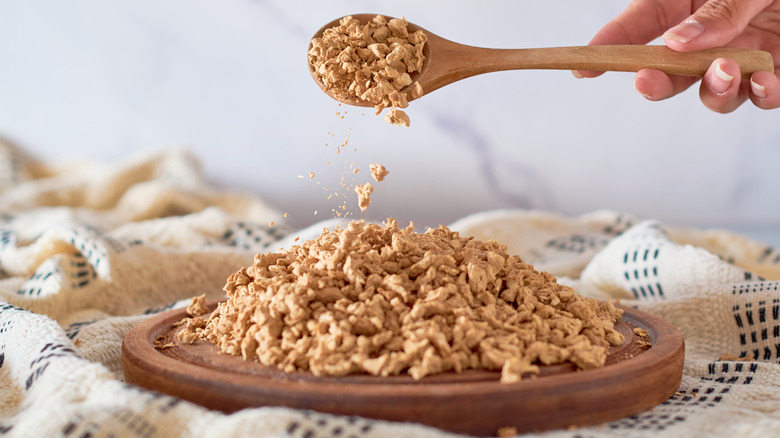What Exactly Is Textured Vegetable Protein (TVP)?
Textured vegetable protein, commonly called TVP, has baffled consumers for years despite its simplicity and versatility. TVP represents the dehydrated protein derived during the process of extruding oil. While it can also be made from other base ingredients, like wheat or oats, soy is almost always the version you'll find on the grocery shelf. And because it's purely soybean, consumers following gluten-free, vegan, and heart-healthy diets alike can enjoy this product.
Visually, TVP looks like tan or light-brown colored crumbles, similar in shape and size to cooked ground meat. Most of the time, you'll find it in a dry, shelf-stable bag, frequently in the flour and baking aisle at your regular grocery store.
To use in recipes, simply rehydrate with hot water or broth for five to 10 minutes. TVP provides almost no intrinsic flavor, so it will act like a sponge to soak up the savors of the liquids and sauces you cook with it.
From a cost standpoint, TVP certainly comes out ahead of the ground meat it often replaces: As of April 2023, the nationwide average cost for ground beef was $5.25 per pound (per U.S. Bureau of Labor Statistics), whereas the equivalent amount of dried TVP to replace 1 pound of ground beef (about 0.33 pounds) clocked in at only $3.46 when purchased from Bob's Red Mill.
TVP is delicious and nutritious
Even though TVP doesn't carry its own strong flavor, it adds a satisfying texture that makes it feel hearty and substantial. Most would describe hydrated TVP as a bit chewy, which may come as a pleasant surprise to some. Unless you know the trick to get tofu crispy or the secret to making beans meatier, many carnivores turn away from vegetarian proteins because of the consistency. TVP is unique because its tougher texture is closer to meat than most replacements.
TVP is high-protein and virtually fat-free, which makes it an excellent candidate for some healthy recipe swaps. Usually, TVP replaces ground beef, so you'll keep the protein punch while reducing saturated fat and cholesterol significantly. TVP provides almost no sodium yet boasts healthy doses of magnesium, potassium, and fiber. According to a 2021 study published in Nutrients, this specific nutrient combination can provide significant heart-health benefits; and soy itself has been shown to reduce cardiovascular risk factors like LDL cholesterol, per a 2019 study in the same journal.
How do you use TVP for cooking?
This nutritious, versatile ingredient proves surprisingly easy to use. All it takes is some hot water and a quick soak to turn those dry crumbs into a ready-to-eat protein. To substitute TVP for one pound of ground meat, for example, simply soak 1 ¾ cups of TVP in 1 ⅓ cups boiling water for about ten minutes, and you're set. To maximize the taste potential of the final product, make sure your hydrating liquid is flavorful, such as using stock, broth, or thinned-out sauce like barbecue or teriyaki.
TVP can hold its own in many of the same dishes you make with ground beef, like casseroles or chili. If you celebrate Taco Tuesday, TVP makes an excellent addition to the many other classic plant-based proteins like black beans or refried beans. First-timers should try gradually increasing the ratio of TVP to ground meat with each recipe batch, as moistness and texture will be slightly different between the two. Even if you're not looking to eliminate meat altogether, you can use TVP as a filler to stretch burger meat to reduce overall beef consumption. With such strong boasts of cost and nutrition, TVP definitely earns a spot in your pantry today.


